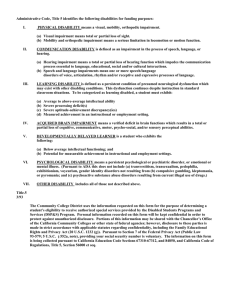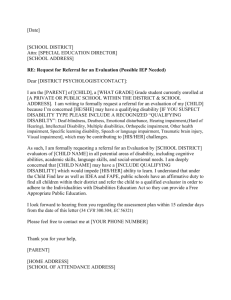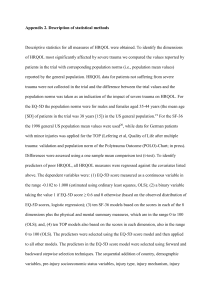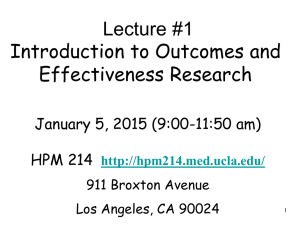View Presentation Abstract - pantherFILE
advertisement
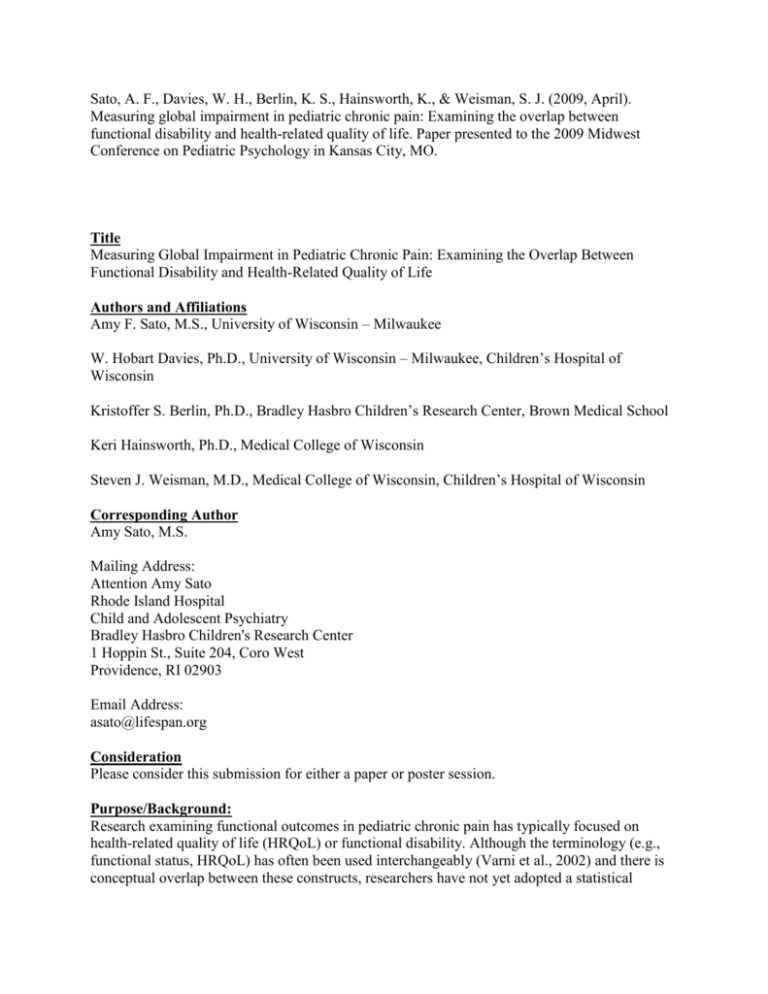
Sato, A. F., Davies, W. H., Berlin, K. S., Hainsworth, K., & Weisman, S. J. (2009, April). Measuring global impairment in pediatric chronic pain: Examining the overlap between functional disability and health-related quality of life. Paper presented to the 2009 Midwest Conference on Pediatric Psychology in Kansas City, MO. Title Measuring Global Impairment in Pediatric Chronic Pain: Examining the Overlap Between Functional Disability and Health-Related Quality of Life Authors and Affiliations Amy F. Sato, M.S., University of Wisconsin – Milwaukee W. Hobart Davies, Ph.D., University of Wisconsin – Milwaukee, Children’s Hospital of Wisconsin Kristoffer S. Berlin, Ph.D., Bradley Hasbro Children’s Research Center, Brown Medical School Keri Hainsworth, Ph.D., Medical College of Wisconsin Steven J. Weisman, M.D., Medical College of Wisconsin, Children’s Hospital of Wisconsin Corresponding Author Amy Sato, M.S. Mailing Address: Attention Amy Sato Rhode Island Hospital Child and Adolescent Psychiatry Bradley Hasbro Children's Research Center 1 Hoppin St., Suite 204, Coro West Providence, RI 02903 Email Address: asato@lifespan.org Consideration Please consider this submission for either a paper or poster session. Purpose/Background: Research examining functional outcomes in pediatric chronic pain has typically focused on health-related quality of life (HRQoL) or functional disability. Although the terminology (e.g., functional status, HRQoL) has often been used interchangeably (Varni et al., 2002) and there is conceptual overlap between these constructs, researchers have not yet adopted a statistical approach to clarify the relationships between these constructs. This study sought to determine through the use of structural equation modeling (SEM) whether functional disability and HRQoL are indicators of a broader “Global Impairment” latent construct. In addition, this study sought to determine whether commonly used clinical indictors of pain hold together as a broader “Pain” latent variable. Methods: Participants were 291 children and adolescents with chronic pain presenting to a tertiary chronic pain clinic. Youth were 8 - 17 years old (M = 13.3, SD = 2.7), primarily female (72.2% female) and primarily Caucasian (80.4%). Over half (52.7%) of patients reported pain duration greater than 1 year. On a 0-to-10 numerical rating scale, participants’ best, worst, and usual pain ratings were 1.7 (SD = 2.4), 8.7 (SD = 1.7), and 5.9 (SD = 2.1). As part of a comprehensive evaluation prior to the establishment of a treatment plan, participants completed a demographics and medical history questionnaire and measures of HRQoL, functional disability, and social consequences of pain. The Pediatric Quality of Life InventoryTM Version 4.0 (PedsQL) Generic Core Scales (Varni et al., 2001) assessed children’s perceptions of their HRQoL in the domains of physical, emotional, social, and school functioning. The Functional Disability Inventory (FDI; Claar & Walker, 2006; Walker & Greene, 1991) provided a unidimensional measure of children’s perceived difficulty in physical and psychosocial functioning due to their physical health. Internal consistencies of the FDI and PedsQL ranged from .86 to .91. Results: A measurement model containing the hypothesized Pain and Global Impairment latent variables was constructed using LISREL 8.54. Because the measurement model was constructed as part of a larger study exploring the relationships between pain, social consequences, child age/gender and functioning, indices of social consequences and child demographics were also included. In the initial measurement model, indictors of Global Impairment were the PedsQL and FDI total scores and indicators of Pain were pain duration and best, worst and usual intensity. Due to model non-convergence, the Global Impairment and Pain latent variables were re-specified (i.e., duration was removed from Pain and a more fine-grained approach was used for Global Impairment). Model fit statistics were evaluated. The CFI (.90), SRMR (.06), and RMSEA (.09) indicated adequate model fit, whereas the NNFI (.80) and SB-χ2/df (2.97) did not. All indicators of Global Impairment and Pain loaded in the expected direction. Conclusions: Functional disability and HRQoL can be conceptualized as arising from a broader Global Impairment latent construct. Pain duration emerged as distinct from other clinical indicators of pain intensity. Given that functional disability and HRQoL appear to be tapping the same underlying construct, it may not be necessary to administer measures of both in a busy clinical setting. .



